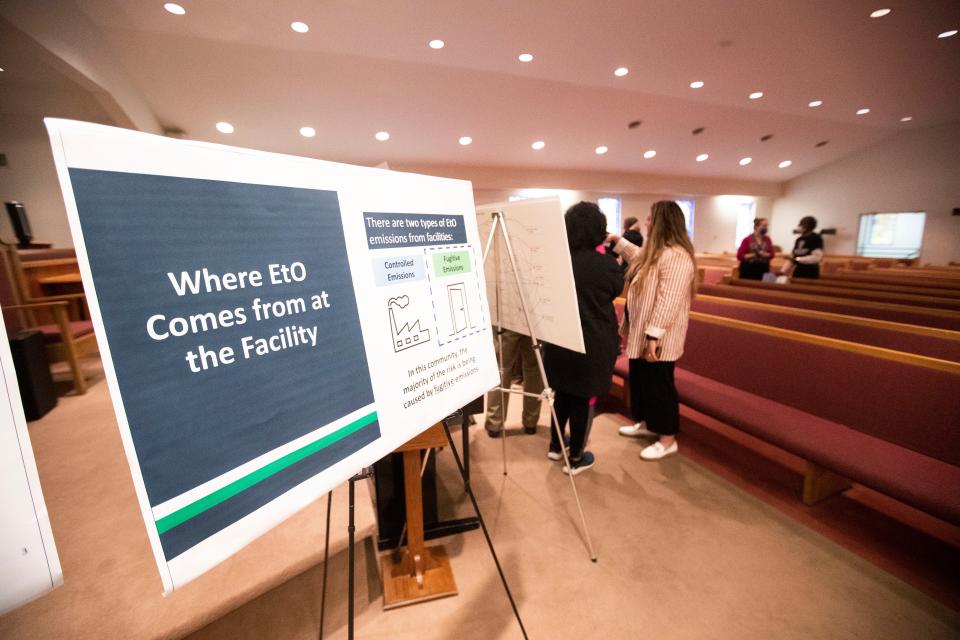Proposed EPA regulations aim to reduce EtO exposures by 80%
The United States Environmental Protection Agency has proposed new standards to reduce exposure to ethylene oxide (EtO), a cancer-causing compound that has been connected to a South Memphis plant, by about 80%.
Sterilization Services of Tennessee, a commercial sterilization facility at 2396 Florida Street, has had EtO at its facility since at least 1979, Dr. Michelle Taylor, the director of the Shelby County Health Department, said in October. Last year, the EPA identified the facility as an elevated risk for those who live in the surrounding areas following newfound concern coming from 2016 data where showed the chemical is about 40 times more toxic than previously thought.
Memphis Community Against Pollution (MCAP) co-founder and former State Representative Justin J. Pearson spoke at a community meeting hosted by the Environmental Protection Agency in October about the cancer risk in the community.

"In 2013 a study came out by Dr. Jia Chunrong at the University of Memphis...Same professor, two months ago, released another study," Pearson said. "We don't need to wait. You want qualitative research? How many people here know somebody who has died of cancer or has been sick themselves?"
In the approximate four-square-mile area in South Memphis, the lifetime risk of cancer for the immediate area is 100 out of 1 million, according to the EPA, meaning that if 1 million people are exposed to the sampled level of EtO for 24 hours a day for 70 years, 100 people are likely to develop cancer.
"EPA’s new analysis estimates the additional lifetime cancer risk associated with continuous workplace exposure to EtO for 8 hours a day, for 240 days per year, over a period of 35 years in an occupational setting is between 1 in 36 and 1 in 10 for workers who apply EtO in sterilization facilities, and between 1 in 25 and 1 in 12 for workers who apply EtO in healthcare facilities," the EPA said in a press release.
The new EPA proposals look to "strengthen and update" the Clean Air Act standards as it relates to EtO, targeting 86 medical sterilization facilities across the United States, including Sterilization Services in Memphis. The EPA said its proposal will reduce emissions by about 80%, reducing about 19 tons of emissions per year.
"While today’s EPA ruling on ethylene oxide is a step in the right direction, more must be done to protect residents living in Southwest Memphis, a predominantly Black community near the Sterilization Services of Tennessee facility," MCAP said in a written statement. "The Shelby County Health Department (SCHD) cannot continue to ignore the voices of this community. It must use its power to require Sterilization Services of Tennessee to reduce these toxic emissions or cease operations immediately."
As of Tuesday evening, the Shelby County Health Department said it was still evaluating the proposed new standards.
The new EPA regulations would strengthen the standards for two different venting practices — sterilization chamber and aeration room vents — and would regulate chamber exhaust vents, a third venting practice, which the EPA deregulated in 2001. Sterilization Services of Tennessee uses all three venting practices, including chamber exhaust vents, which are commonly called back vents.
The EPA has monitored and regulated EtO for decades, with venting practices having regulations in 1994 as a way to limit the concentration of the chemical for the air surrounding a facility, with inhalation being the most common way for people to ingest EtO. Sterilization Services of Tennessee uses three different venting practices, one of which has been unregulated by the EPA since 2001.
Between 1994 and 2001, all three practices — sterilization chamber vents, aeration room vents and chamber exhaust vents — were controlled by the EPA. However, in 2001, chamber exhaust vents, which are commonly called back vents, were deregulated. The deregulation stemmed from some facilities overfeeding their monitoring machines in 1997, causing explosions at a few of the locations. The EPA conducted an investigation and, in 2001, stripped all regulations for back vents.
The regulations also target fugitive emissions, which are EtO emissions that could enter the air from unsealed windows or open doors. It would also establish regulations for starting and stopping the use of sterilization equipment, along with any malfunctions, including an end to EPA exemptions for those processes.
Also included are requirements that make facilities continuously monitor air pollution levels, and mandate reports to the EPA twice a year.
A 60-day public comment period will take place once the proposal is posted to the Federal Register, and a public webinar will be hosted on May 1. Once the final regulations are set, facilities that use EtO will have 18 months to be compliant with the regulations.
Although the proposed regulations focus on sterilization facilities, the EPA said it is also reviewing standards for other sources that have EtO emissions, and on April 6, proposed a rule that would "significantly reduce emissions of EtO from chemical manufacturing facilities."
Lucas Finton is a news reporter with The Commercial Appeal. He can be reached at Lucas.Finton@commercialappeal.com and followed on Twitter @LucasFinton.
This article originally appeared on Memphis Commercial Appeal: Proposed EPA regulations aim to reduce EtO exposures by 80%

